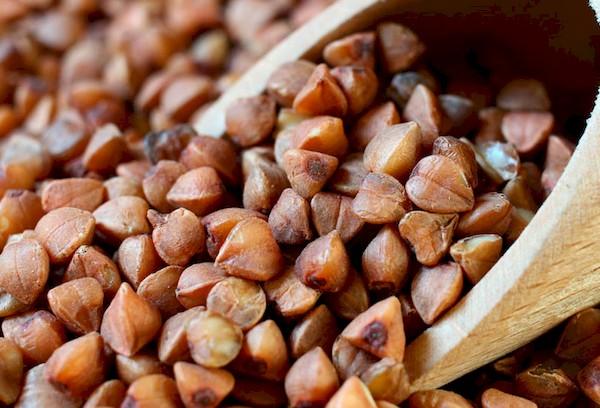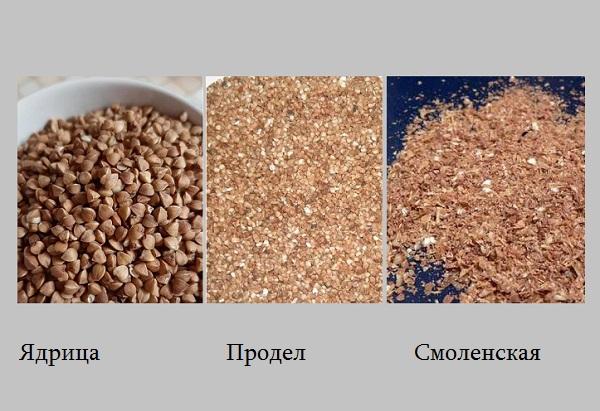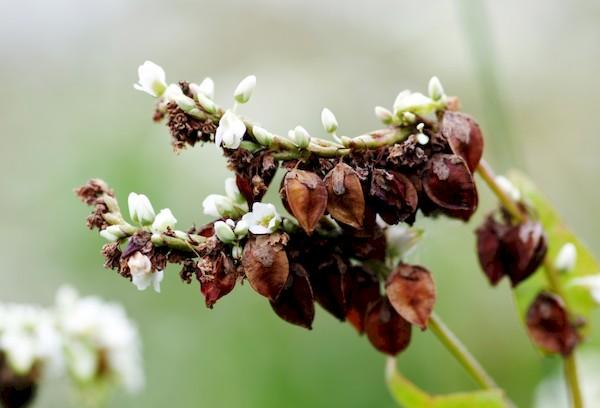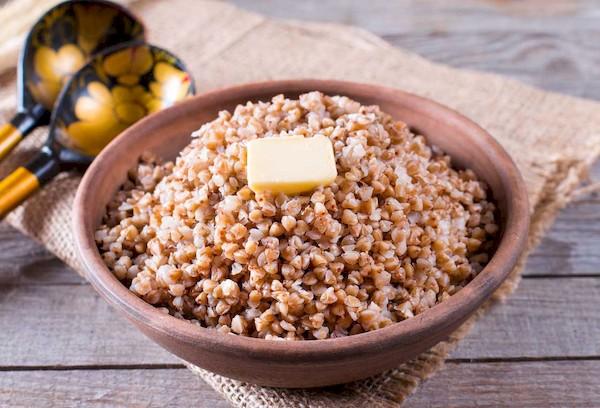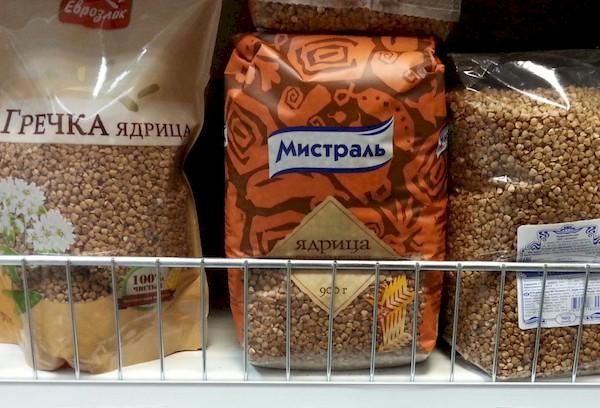Buckwheat or buckwheat
Buckwheat is a cereal obtained from the fruits of common buckwheat (seed, edible). The culture is a representative of a species of herbaceous plants of the Buckwheat family (Polygonaceae), the genus Buckwheat (Fagopyrum). It is a cereal and melliferous plant that is consumed by humans and is suitable as feed for some farm animals. It should not be confused with Tatarian buckwheat, a spring annual weed that infests grain crops.
What is buckwheat made from?
Buckwheat grains are found in the inflorescences of the plant. After flowering completes, triangular seeds are formed in place of the flowers, shaped like a small nut. By the end of August-beginning of October, depending on the region of growth, they ripen and are ready for harvest. In the process of producing buckwheat, the grain mass is cleaned of impurities, sorted and subjected to heat treatment.
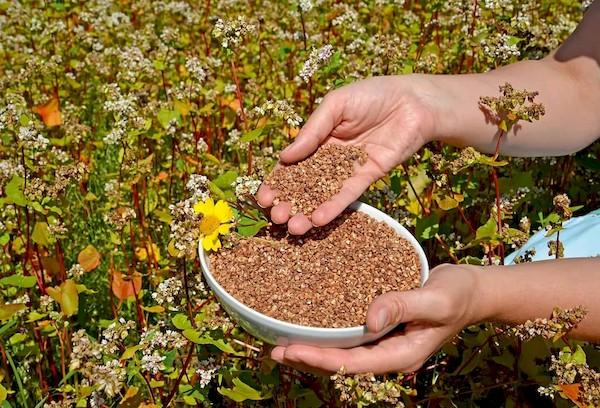
Consumers often wonder whether buckwheat is a grain or not, and many mistakenly classify it in this category. But, in fact, she is not. Cereal crops include monocots: wheat, rye, oats, rice, corn, barley, millet, sugar cane and bamboo. Buckwheat, on the other hand, is a pseudo-cereal, and in a botanical sense is closer to sorrel, whose seeds are also formed in inflorescences and resemble buckwheat in appearance. And, unlike cereals, buckwheat does not contain gluten, and its composition contains many times more microelements than other grains.
What is contained in 100 grams of buckwheat
Raw buckwheat contains 313-330 Kcal per 100 g, BZHU - 13/3/62 g, respectively. Buckwheat cooked in water has different indicators for the same amount of product:
- calorie content – 97 Kcal;
- proteins – 3.9 g;
- fats – 1 g;
- carbohydrates – 19.2 g.
Buckwheat contains a number of useful substances. The flowering aerial part is rich in rutin, fagopyrin, gallic, chlorogenic and caffeic acids. And the seeds are a valuable source of the following elements:
- magnesium;
- gland;
- calcium;
- potassium;
- phosphorus;
- iodine;
- zinc;
- fluorine;
- molybdenum;
- cobalt;
- riboflavin;
- thiamine;
- vitamins B1, B2, B9, E, PP;
- maleic, menolenic, oxalic, malic and citric acids;
- fiber, dietary fiber, etc.
In terms of the volume of lysine and methionine, which make up the protein of buckwheat seeds, this cereal surpasses all other cereal crops. And the carbohydrates contained in it take longer to digest than, for example, the carbohydrates of pearl barley and millet, due to which the feeling of fullness from buckwheat porridge lasts much longer.
Types of buckwheat
Buckwheat that goes on sale is divided into several varieties:
- Yadritsa - This is a whole grain, which, in turn, is divided into 4 grades (highest, first, second and third). The differences lie in such quality indicators as color, smell, taste, boilability, percentage of impurities, unhulled grains, etc.
- Done – is a mass of crushed buckwheat seeds, it can be large or small.
- Smolensk groats – is done by crushing and “running in” the kernel.
The cereal is sold peeled, polished or fried, and its color varies from yellow-brown to dark brown. And the product known as “green buckwheat” (due to its thick grassy hue) is unroasted grains.Such cereals are considered dietary and are much more expensive than processed ones.
Where does buckwheat grow?
Most of the volumes of buckwheat entering the world market are produced in Russia. Today, buckwheat is grown in 49 regions of the country. The leading regions, which account for approximately three quarters of the gross harvest, are the Kursk, Voronezh and Oryol regions, the Republic of Bashkortostan and the Altai Territory. Buckwheat fields are traditionally located in illuminated, well-warmed areas by the sun, preferably near rivers so that the soil is sufficiently moist.
Buckwheat is also made in Ukraine and Kazakhstan. These states, along with Russia, are considered the largest suppliers. Buckwheat also grows in other countries - China, India, Poland, Turkey, Brazil, Latvia and the USA, but production volumes are an order of magnitude smaller.
What is prepared from buckwheat - 10 popular dishes
Buckwheat is a nourishing and healthy product; it is stored for a long time, does not become moldy and does not acquire the bitterness characteristic of many cereals over time.
Many types of dishes are prepared from it:
- Porridge with milk. They are flavored not only with butter and sugar, but also with vegetable and fruit purees (for example, pumpkin or apple), as well as fresh or frozen berries.
- Side dishes. The cereal is boiled in water and eaten in its “pure” form, or fried onions, mushrooms, carrots, green beans, etc. are added, supplemented with sauces and ketchups. They also prepare a dish from boiled kernels, which is called “merchant-style buckwheat” - the cereal is mixed with fried chicken giblets and seasoned with a mixture of poached onions, carrots and tomatoes.
- Soups. First courses with buckwheat can be either meat or lean, cooked in vegetable broth.This grain is also sometimes added to pickles and cabbage soup.
- Casseroles. There are many variations of these dishes - cereals are mixed with meat, poultry, vegetables, fruits, and berries.
- Cutlets, meatballs, rolls. Boiled buckwheat is added to minced meat or used as a filling for rolls. Cutlets or meatballs are often additionally stewed/baked with fried vegetables, in a sauce made from sour cream or tomato paste, etc.
- Puddings. The simplest version of this dish is a mixture of boiled cereal, whipped egg whites and sugar, baked in the oven or slow cooker. Since time immemorial, the so-called “krupenik”, which is made with the addition of cottage cheese, has also been popular among domestic housewives.
- Salads. Boiled, and sometimes additionally fried in oil, cereals are combined with meat, green beans, carrots, bell peppers, pickled and fried mushrooms, onions, etc. There are many options for salads with buckwheat, both filling and high-calorie, as well as dietary.
- Flour products. Pre-boiled buckwheat, whole or chopped, is added to the dough for pancakes, flatbreads, dumplings, or replaces porridge with buckwheat flour. The latter is also suitable for making pancakes, bread, and pasta.
- Bread. In this case, buckwheat flour is mixed with wheat flour in a ratio of approximately 1:3, respectively, otherwise the dough will be sticky, will not rise and will not bake well.
- Tea. A drink made from green buckwheat is very popular in China. It is believed to purify the blood and lower blood pressure.
Due to its rich vitamin composition, buckwheat has also found use in folk medicine.On its basis, remedies for coughs, diseases of the respiratory and cardiovascular systems are prepared, as well as ointments and compresses for external use, both medicinal and cosmetic.
How to choose quality buckwheat in the store
Buckwheat is packaged in cardboard packs, paper or plastic bags. The latter option is preferable, since the consumer can assess the condition of the contents - the kernel should not contain foreign impurities, debris, or insects. It is also worth paying attention to the integrity of the packaging and the information indicated on it.
The manufacturer must provide the following information:
- name and variety of cereal;
- name and address of the enterprise that produced the product;
- net weight;
- date of manufacture;
- shelf life;
- nutritional and energy value;
- name and number of the document in accordance with which buckwheat was produced (TU or GOST).
As a rule, the shelf life of buckwheat is 18-20 months from the date of production. If the storage duration indicated on the packaging exceeds the specified norm, in most cases this means that the quality of such a product leaves much to be desired.
What type of cereal to choose, kernel or prodel, depends on what the housewife plans to cook from it. For viscous porridge, meatballs, casseroles and baby food, the following procedure is more suitable. And if you need to make a side dish, salad, soup or casserole, you will need a crumbly mass. This means that you need to take whole grains.
What is the difference between buckwheat and buckwheat?
Often in colloquial speech there are phrases “buckwheat grows” or “cook buckwheat”, that is, ordinary people equate these names, which is wrong.
Buckwheat is a plant, a cereal crop.Buckwheat (buckwheat) is a cereal made from buckwheat seeds (grains). That is, the fruits of buckwheat themselves are not buckwheat as such; this phrase is used as a trade name for a product that has undergone industrial processing.
However, in some sources, the word “buckwheat” can mean not only a kernel or product ready for sale, but also ripe, unprocessed seeds.
